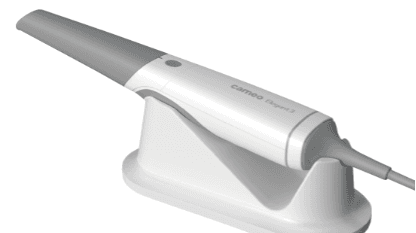
At Power Dental we try to keep up with as many technological advancements as we can. The most recent of these is our Intra-Oral Scanner, which we started to employ in 2023.
What is an Intra-Oral scanner?
It is a device a lot like a video camera which takes 3 Dimensional (3D) images of your mouth to get an impression. It is often called an optical impression. We can take this scan or optical impression of your teeth and gums instead of a traditional impression with elastic materials in impression trays in the mouth. This is when we are making crowns, bridges, in orthodontics and for some dentures. We see the picture of the scan in real time on the computer screen.
What does the scanner look like?

What do the scans look like?

What are the advantages of our intra-oral scanner?
There are 4 main advantages we have found since we started using our intra-oral scanner:
1. The scans are very precise and our labs are producing excellent results for us. While traditional impressions are usually very good, there can be problems when movement occurs and they can distort and affect the accuracy. This leads to better-fitting restorations, orthodontic aligners, dentures, snoring devices and bite splints , resulting in less adjustments and saving us and you time and discomfort.
2. Scanning is more pleasant and comfortable than traditional impressions. Traditional impressions can take quite some time and can be messy and uncomfortable, especially for people with a sensitive "Gag" reflex. Scanning is usually quicker, less invasive and so more pleasant. Overall it is a better experience for the patient, meaning that they are coming to the dentist with one less thing to worry about and not look forward to!
3. Scanning means a faster turnaround for laboratory work. In practice we scan your mouth and then email that straight after to the laboratory. They can then check it to see if there are any queries and start working on it as soon as possible - printing out a model on a 3D printer. Previously with traditional impressions we would need to take the impression and then send it by a courier to a laboratory, which usually meant they would receive it the next business day at best. They would then pour the plaster cast and then look at the outcome and start working after that. The result is that the patient doesn't need to wait as long to get their restoration, denture, aligners, etc.
4. Scanning comes onto a computer screen in front of the dentist and patient immediately and we can look at it together. This means that the dental professional and the patient can see how everything looks and then the professional can explain what's what and the treatment options. The improved education and patient interest and engagement in their own oral health has been remarkable!
So, in a few short month our intra-oral scanner has made a big impact on the way we practice dentistry and improved the experience for our patients - making things better, quicker and more comfortable As technology continues to advance, it seems a safe bet to say that scanners will play a big role in making things better for both the dental professional and the patient alike.

